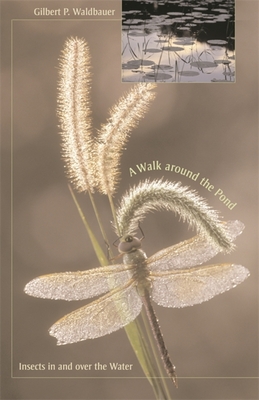

 Harvard University Press
Harvard University Press
A Walk Around the Pond: Insects in and Over the Water


Key Metrics
- Gilbert Waldbauer
- Harvard University Press
- Paperback
- 9780674027657
- 7.74 X 5.08 X 0.73 inches
- 0.68 pounds
- Nature > Animals - Insects & Spiders
- English
 Secure Transaction
Secure TransactionBook Description
A water strider darts across a pond, its feet dimpling the surface tension; a giant water bug dives below, carrying his mate's eggs on his back; hidden among plant roots on the silty bottom, a dragonfly larva stalks unwary minnows. Barely skimming the surface, in the air above the pond, swarm mayflies with diaphanous wings. Take this walk around the pond with Gilbert Waldbauer and discover the most amazingly diverse inhabitants of the freshwater world.
In his hallmark companionable style, Waldbauer introduces us to the aquatic insects that have colonized ponds, lakes, streams, and rivers, especially those in North America. Along the way we learn about the diverse forms these arthropods take, as well as their remarkable modes of life--how they have radiated into every imaginable niche in the water environment, and how they cope with the challenges such an environment poses to respiration, vision, thermoregulation, and reproduction. We encounter the caddis fly larva building its protective case and camouflaging it with stream detritus; green darner dragonflies mating midair in an acrobatic wheel formation; ants that have adapted to the tiny water environment within a pitcher plant; and insects whose adaptations to the aquatic lifestyle are furnishing biomaterials engineers with ideas for future applications in industry and consumer goods.
While learning about the evolution, natural history, and ecology of these insects, readers also discover more than a little about the scientists who study them.
Author Bio
Gilbert P. Waldbauer (1928- ) served as Professor of Entomology (1960-1995) at the University of Illinois. He studied agricultural pests, pest management, mimicry, and insect mating but he also wrote books on biology and entomology for the general public. Throughout his career Professor Waldbauer worked internationally as a researcher and government consultant.
Gilbert P. Waldbauer was born on April 18, 1928, in Bridgeport, Connecticut. He served in the U.S. Army Honor Guard to General Douglas MacArthur from 1946 to 1947, and was stationed in Tokyo, Japan, during this time. Upon returning to the U.S., Waldbauer completed his Bachelor of Science degree in entomology in 1953 at the University of Massachusetts. He then earned his Master of Science and Ph.D. in entomology at the University of Illinois at Urbana-Champaign, in 1956 and 1960, respectively.
Waldbauer served as a professor of entomology (1960-1995). He toured the country speaking about natural history for the Massachusetts Conservation Council (1952-1953). He was an associate member of the Center of Zoonoses Research (1963-1964) and a research affiliate in entomology at the Illinois State Natural History Survey (1970). Internationally, he was a visiting scientist at the Instituto Colombiano Agropecuario in Palmira, Columbia (1971); a senior scientist at the International Rice Research Institute in the Philippines (1978-1979); and a USAID consultant to the Pakistan Agricultural Research Council in Islamabad, Pakistan (1985).
Professor Waldbauer is nationally and internationally recognized for his research into the adaptive significance of individual and group behavior among insects, including cecropia moths, bean leaf beetles, whiteflies, South American stink bugs, and corn earworms. During his career, Waldbauer authored and co-authored more than 100 academic articles. He also served as a reviewer for the National Science Foundation, and he was awarded grants from U.S. Department of Agriculture and the National Geographic Society for his research on agricultural pests and pest management.
Since his retirement, Waldbauer has published several popular science books, including Insects through the Seasons (1996), The Handy Bug Answer Book (1998), Birder's Bug Book (1998), Millions of Monarchs, Bunches of Beetles: How Bugs Find Strength in Numbers (2000), What Good are Bugs? Insects in the Web of Life (2003), Insights from Insects: What Bad Bugs Can Teach Us (2005), A Walk around the Pond: Insects in and over the Water (2006), and How Not to Be Eaten (2012).
Source: University of Illinois Archives
Videos


Community reviews
Write a ReviewNo Community reviews